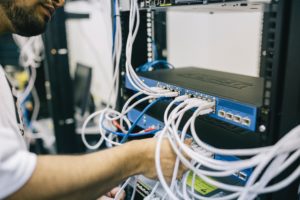
Ensure that your fiber optic cabling is in the best working condition by following these troubleshooting steps.
Fiber optic cabling has become so ubiquitous in the networking world thanks to its ability to transmit huge amounts of data at the speed of light. Everything from home routers, personal computers, and audio-visual setups take advantage of the tech, and while many of the issues that come with traditional copper cables are circumvented with fiber, there are still issues that can develop. Thankfully, troubleshooting fiber optic cabling is easy provided you follow the below steps.
Inspecting Cables
If you suspect a specific cable is at fault, perform a visual inspection first. If you notice any excessive bends in the cabling, do what you can to straighten it out with a minimum of stress and make sure there are no spots where a lot of pressure is being applied to the cable. Fiber optic cabling should, for best performance, have a bit of slack, as tension can cause stress on fibers and reduce efficiencies. If you notice any splits, rips, or tears in your cables, they ought to be replaced outright. One tip for checking if a cable is physically damaged: shine light through one of the connectors of your cable using a qualified light source for that product. The light should shine through to the other side.
Troubleshooting Connections
Find where your fiber optic cable terminates on both ends, a fiber optic enclosure, workstation outlet or devices, like a television or router, and ensure that the connection is firmly secured. A single fiber optic cable may have multiple points of termination (fiber enclosure panels, fiber patch cords, work area outlets…), check all connections. It may be as easy as making sure the connector is seated properly or cleaning the connector tip (use of an appropriate, manufacturers recommended cleaning product is recommended).
General Tips
If possible, avoid running cables through high-traffic areas, footsteps and rolling chairs can both do damage to cables over time. Avoid bending, twisting or placing undo stress on fiber cables. Making sure that your cable management is as clean and neat as possible goes a long way in preventing damage as well. It’s generally best practice to avoid touching the connectors of your cables with uncovered fingers as well.
Get in Touch with FiberPlus
FiberPlus has been providing data communication solutions for over 25 years in the Mid Atlantic Region for a number of different markets. What began as a cable installation company for Local Area Networks has grown into a leading provider of innovative technology solutions improving the way our customers communicate and keeping them secure. Our solutions now include:
- Structured Cabling (Fiberoptic, Copper and Coax for inside and outside plant networks)
- Electronic Security Systems (Access Control & CCTV Solutions)
- Wireless Access Point installations
- Public Safety DAS – Emergency Call Stations
- Audio/Video Services (Intercoms and Display Monitors)
- Support Services
- Specialty Systems
- Design/Build Services
FiberPlus promises the communities in which we serve that we will continue to expand and evolve as new technology is introduced within the telecommunications industry.
Have any questions? Interested in one of our services? Call FiberPlus today 800-394-3301, email us at info@fiberplusinc.com, or visit our contact page. Our offices are located in the Washington, DC metro area, Richmond, VA, and Columbus, OH. In Pennsylvania, please call Pennsylvania Networks, Inc. at 814-259-3999.
Do you enjoy clicking “Like” and “Follow?” Be sure to click on our official Google+, Pinterest, Facebook, Twitter, and LinkedIn pages today!